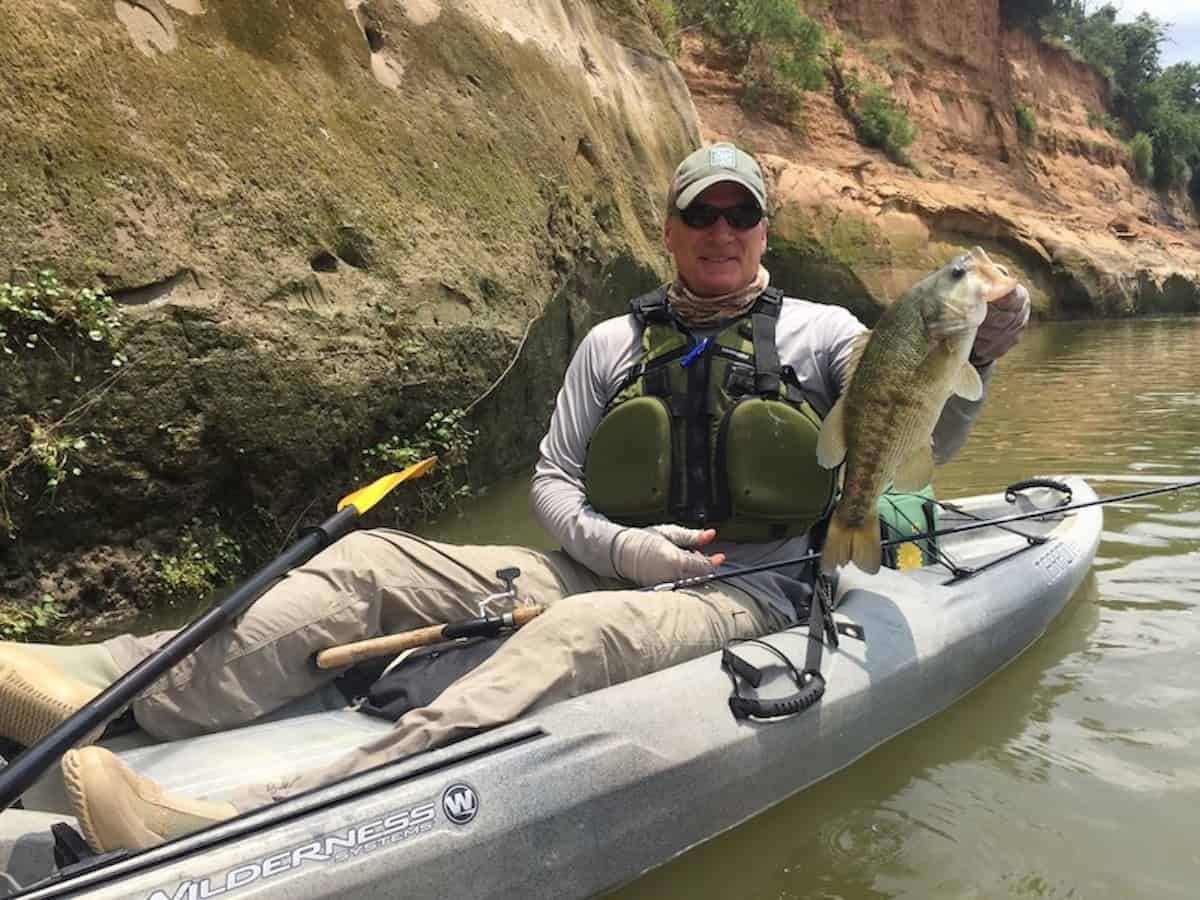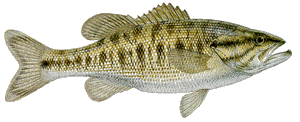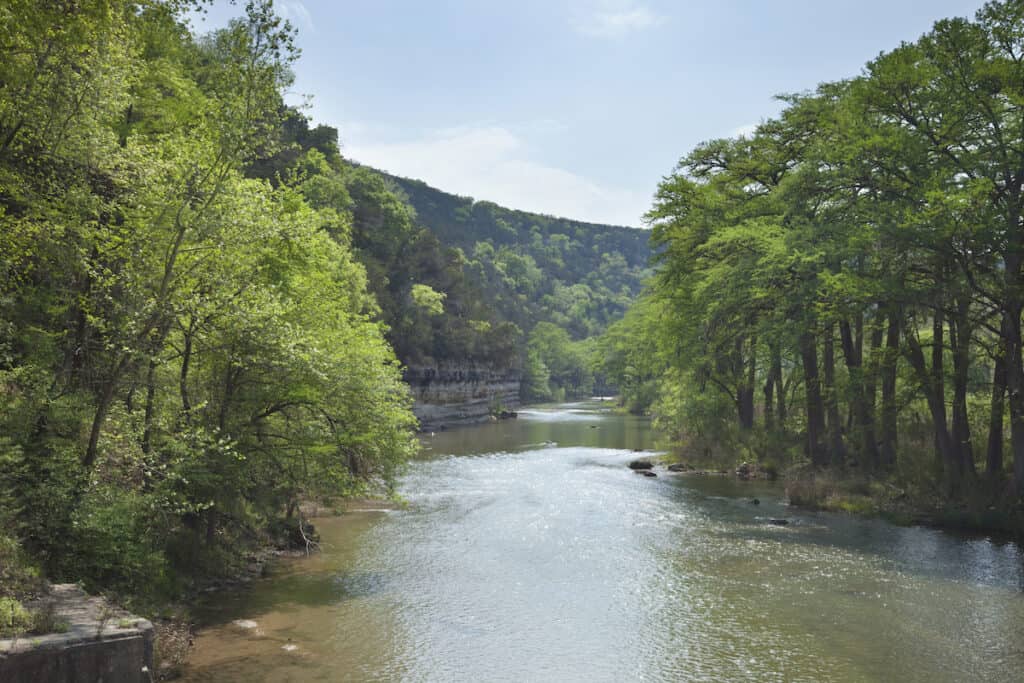Texas offers quite a few unique fishing opportunities, but none more unique than the Guadalupe bass.
The Guadalupe bass is the official state fish of Texas, and it is endemic to the Edwards Plateau, a region that overlaps the Texas Hill Country in the central part of the state. They’re found nowhere else on Earth.
Unlike largemouth bass, Guadalupes are most at home in moving water, and their typical habitat is the upper reaches of cool spring-fed rivers and streams in this part of the state.
A Guadalupe bass’s behavior is, at times, almost trout-like, and they’re commonly caught by fly fishing.
Guadalupe bass aren’t as well-known as their large-mouthed brethren, but they’re beloved by local anglers.
Although they average only 12 inches and about a pound (the state record is a mere 3.71 pounds), they’re still hard fighters on light tackle.
These fish faced the threat of extinction toward the end of the 20th century due to habitat alteration and hybridization with non-native smallmouth bass, but efforts from Texas Parks & Wildlife have restored them within much of their native range.
Most anglers who catch Guadalupe bass practice catch-and-release, not because they are required to do so, but out of respect for this unique and precious fish.
Guadalupe Bass Identification
Identifying Guadalupe bass can be tricky. These fish have features that could be described as a cross between largemouth and smallmouth bass, and are perhaps most similar to spotted bass.
Coloration of Guadalupe bass is generally green to olive, with a series of mostly separate diamond or oval-shaped markings along the lateral line.
Unlike smallmouth bass, the markings do not take the form of vertical bars; and unlike spotted bass, the markings extend much lower on the body.
Guadalupe bass can be differentiated from largemouth bass by their jaw, which does not extend past the eye. Guadalupe bass also have a patch of teeth on their tongue, which are absent in both largemouth and smallmouth bass.
Native Range and Habitat
Guadalupe bass are native to rivers throughout the Edwards Plateau region of Central Texas. The Guadalupe River is the core artery of their native range, along with the Llano, San Marcos and Colorado Rivers.
Anglers also catch Guadalupe bass in smaller run-off streams including Barton and Onion Creeks, the San Gabriel River and Comal River.
Generally speaking, Guadalupe bass are more common in the upper headwater sections of rivers. They prefer clear, swiftly-moving water.
Guadalupe bass were historically found in the Brazos River drainage, but have mostly been eliminated due to competition and hybridization with smallmouth bass.
They are still present in the headwaters of the San Antonio River, but are largely absent from the majority of this waterway.
Fishing Tips & Tactics
The first step to catching Guadalupe bass is finding Guadalupe bass.
These bass often share their home rivers with largemouth and spotted bass, but they favor different habitats. While largemouths seek out sluggish backwaters, Guadalupe bass thrive in the current.
Guadalupe bass often hunt right along the seam between moving and slack water, and are commonly caught in eddies below boulders and other current breaks.
The rivers they inhabit are mostly clear and rocky, and they often hide along rock ledges. If there are stumps, deadfalls or cypress trees present, these are also good spots to target.
The best lures for Guadalupe bass are scaled-down versions of largemouth lures. Small crankbaits, spinners and topwaters are effective, as are jigs and various soft plastic lures, including grubs, tube jigs, wacky worms and creature baits.
Despite their relatively small size, Guadalupe bass are active predators, and they’re usually willing to chase after a fast-moving lure unless they’ve been spooked or startled.
Fishing for Guadalupe bass often requires some wading, so move slowly to avoid alerting the fish to your presence.
Many Texas rivers that harbor these fish are also conducive to kayak or float tube fishing, which is a great way to explore more water with great stealth.
Light to medium-light spinning tackle is just about right for Guadalupe bass. Any line heavier than 8-pound mono is overkill, and low-visibility line is best in clear streams.
Guadalupe bass are more inclined than other bass species to eat insects, and they are often targeted by fly fishing.
Fly anglers often catch Guadalupe bass nymphing with gold-ribbed Hare’s Ear nymphs and Utah Killer Bugs. Wooly buggers and crayfish patterns are also very effective.
Dry flies and poppers are also good choices, and often tempt feisty surface strikes from Guadalupe bass. Sneaky Petes and Dave’s Bass Hopper are great patterns. A lot of the best panfish flies are also irresistible for Guadalupe bass.
Best Fishing Spot
The Guadalupe River is the first place that comes to mind for catching Guadalupe bass, and for good reason. Not only is it the heart of their native range, but also one of the rivers that continues to most reliably yield substantial catches.
Way up in the upper part of the Guadalupe River, Kerr Wildlife Management Area provides two miles of river access where fishing is allowed. Much of the upper Guadalupe River is privately owned, so this spot provides a great opportunity for anglers.
Farther downriver, Guadalupe State Park is another good spot, offering a 4-mile stretch of river with hiking trails and campsites. The only problem is that the river here can get crowded with swimmers and tubers.
Farther still, and the river is dammed to form Canyon Lake (the lake itself is often better for smallmouth bass fishing). The stretch of river below Canyon Dam offers some of the best Guadalupe bass fishing, and the river is a little wider here and more easy to navigate by kayak or float tube.
The river immediately below the dam is also stocked with trout, making it the best trout stream in Texas. But head a little farther down to beat the crowds and access better bass water.
Numerous campgrounds and resorts cater to anglers along this stretch of river, located between San Antonio and Austin.



